How do I log in?
To log in, click on the login button in the menu bar. You will now see the "Where are you from?" page by our
authorization and authentication partner Liblynx. Choose your access mode - SAML, individual login, or
passcode - and enter your details. After successful authentication you are taken back to the homepage of Brill's
Scholarly Editions.

Brill's Scholarly Editions also supports IP recognition. If this is enabled for your institution, there is no need to log in as described here.
How do I search?
For full-text searches across the entire platform, please click on Search All in the top menu
bar of Scholarly Editions. To search in a particular publication, users can either:
- Use the full-text search bar
- Use the filtered search on the left-hand side
Use the full-text search bar
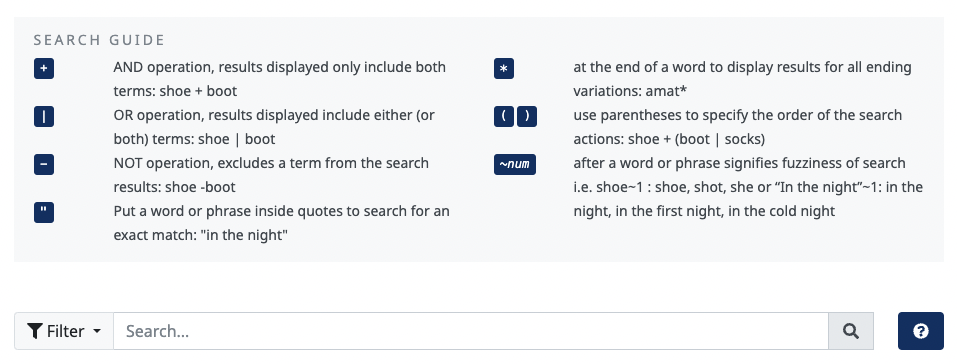
When a word or phrase is entered in the full-text search bar, results can be grouped by 'works,' 'versions,' or 'passages'.
See the bar 'Group by' at the top of the left hand filter.
For more information about the exact meaning of works, versions, and passages please view About in
the top menu bar of Scholarly Editions.
For instance, in Apuleius Online, when one searches for the word 'animalia', the word is found in all three works
of Apuleius (Metamorphoses, Apologia, and Florida). The number of 'passages' in which the word occurs in each text
is given as a blue link (e.g. below, '12 passages' in the Metamorphoses). Clicking on the blue link will redirect
to the search results within the publication of choice.

Refine the full-text search query
There are many ways to refine your query in the search bar. The following search options can be used separately or in combination.
+ AND operation: It is possible to search for two words, names or phrases that are mentioned
together in the same passage, for example Αἰγυπτίων + Βαβυλωνίων. This gives 6 results:
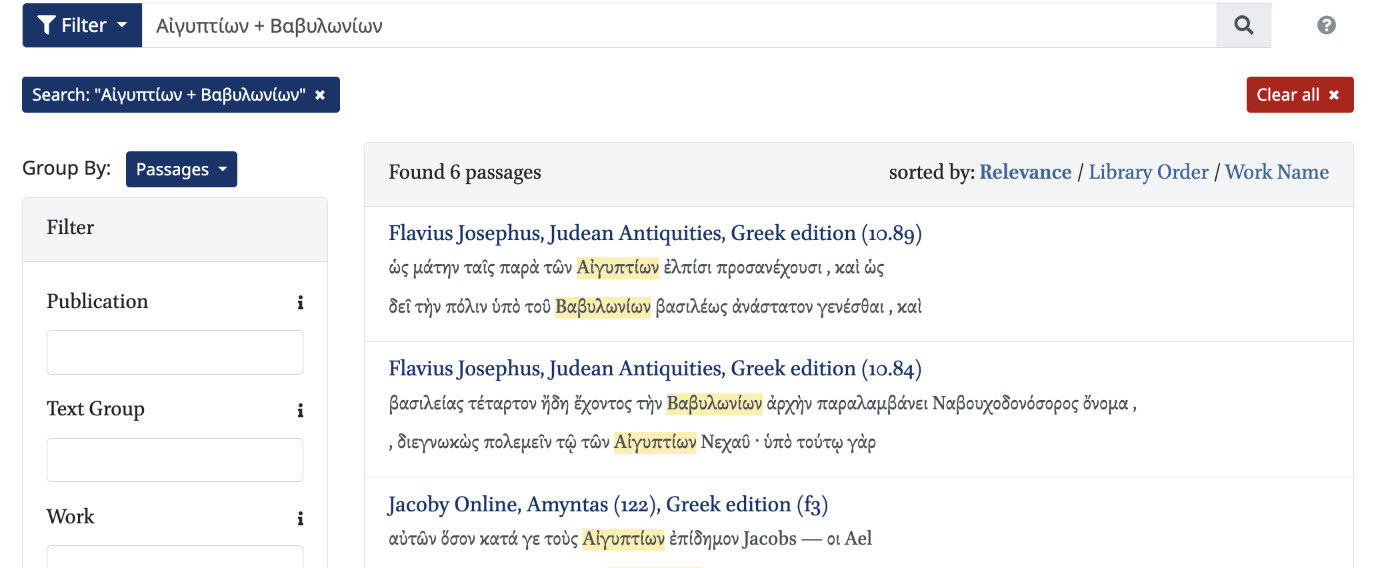
| OR operation: It is possible to search for every instance where
either one or the other is mentioned in a passage, by adding a pipe symbol (vertical bar, Unicode U+007C) between
the words, names or phrases, for example Ἡρακλῆς | Ἵππιας. This gives 3.566 results:
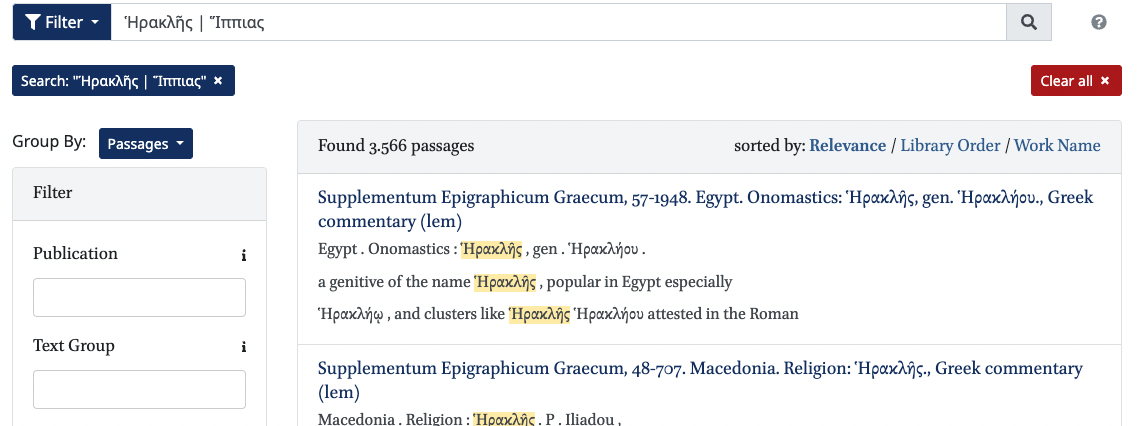
- NOT operation: It is possible to search for any passage that does
mention one but does not mention the other, for example Ἡρακλῆς -Ἵππιας. This gives 2.942 results:
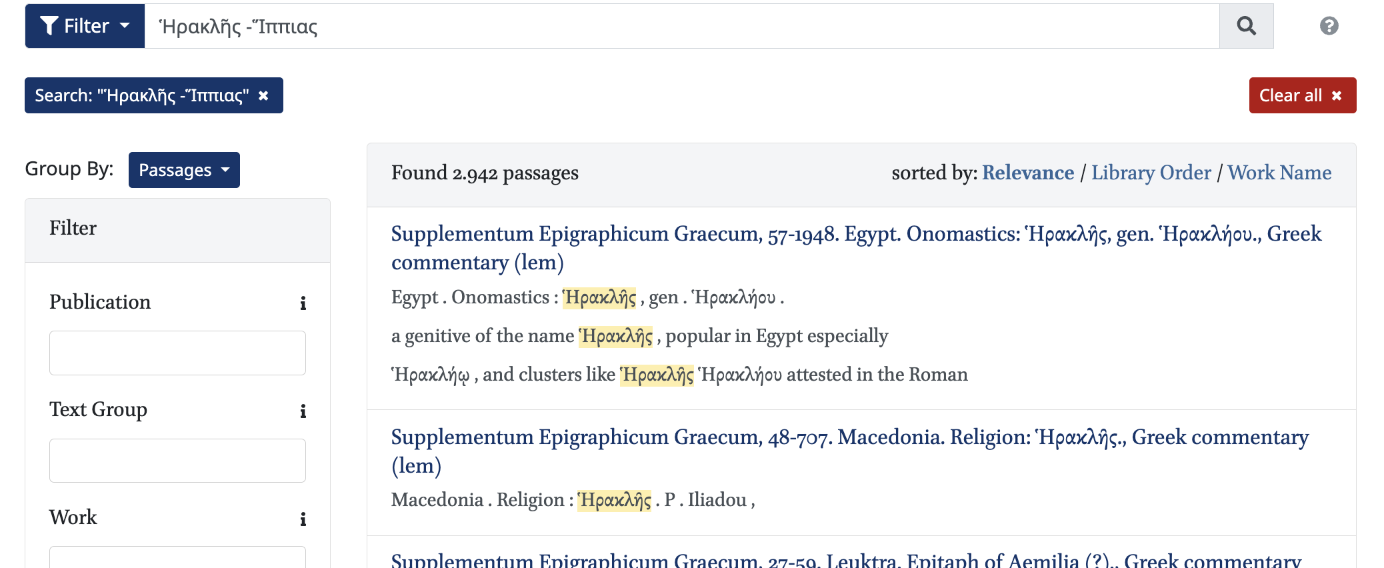
" If you want to search for a string of words, put a word or phrase inside quotes to search for
an exact match, for example "μετὰ δε ταῦτα". This gives 329 results.
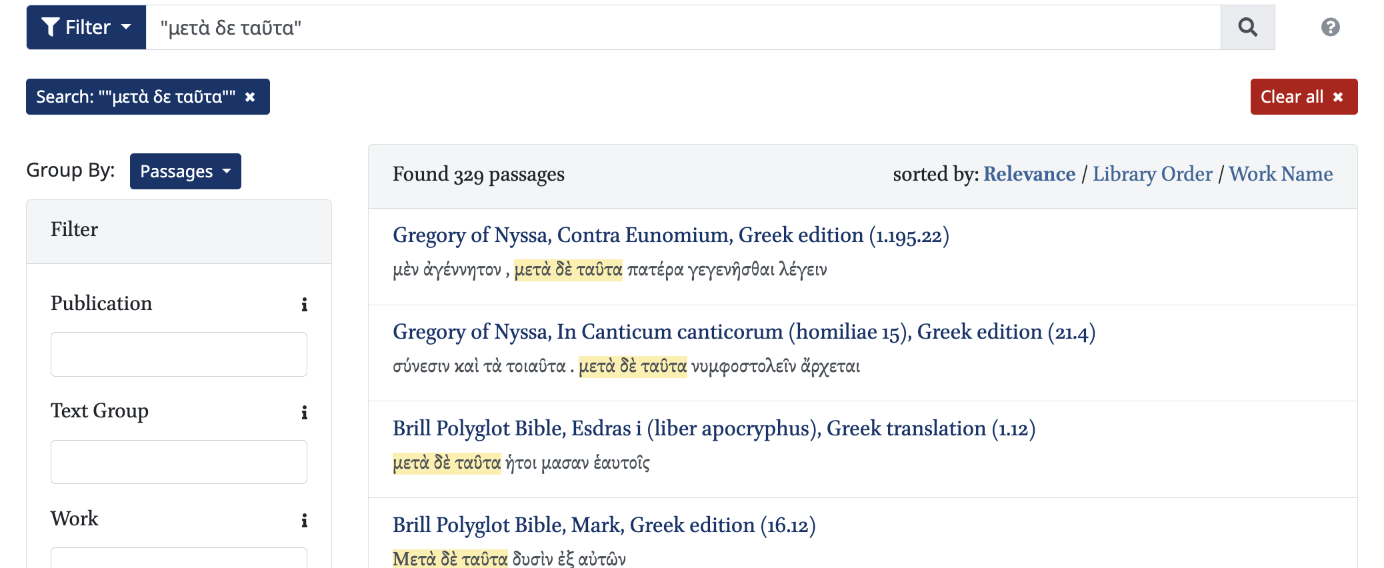
If μετὰ δε ταῦτα is not put inside quotes, it will include all results in which the words appear:
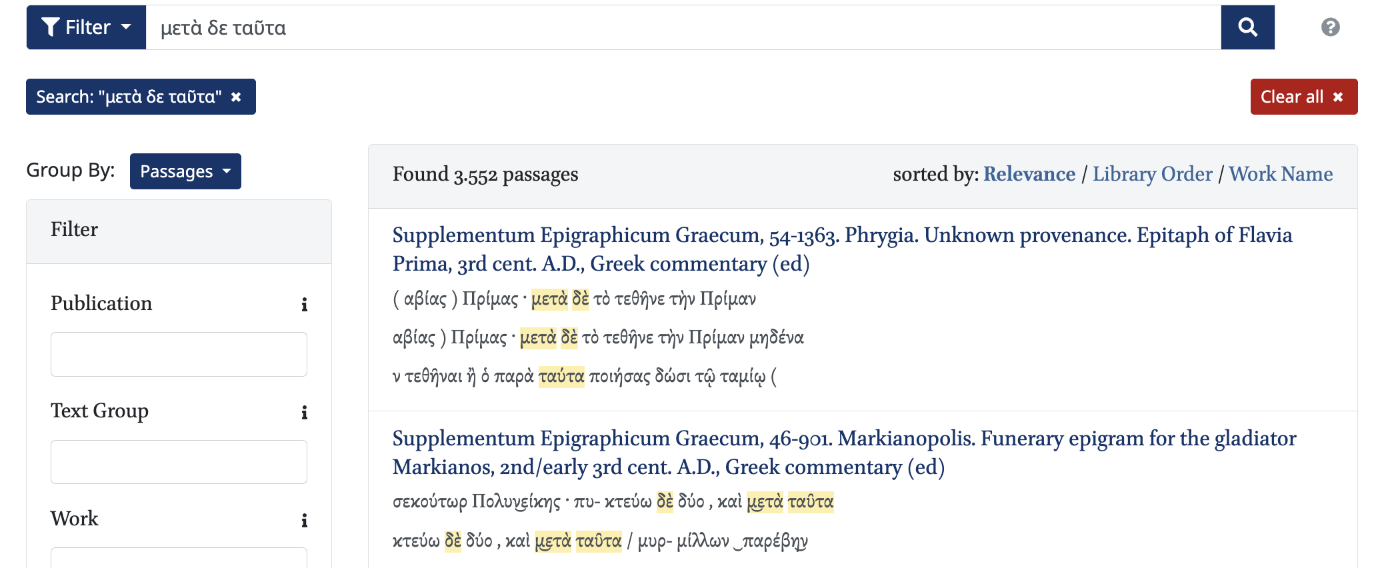
* If you want to search for all ending variations of a certain word, it is possible to add an asterisk
after the root, for example: λεγ*. This gives 25.290 results:
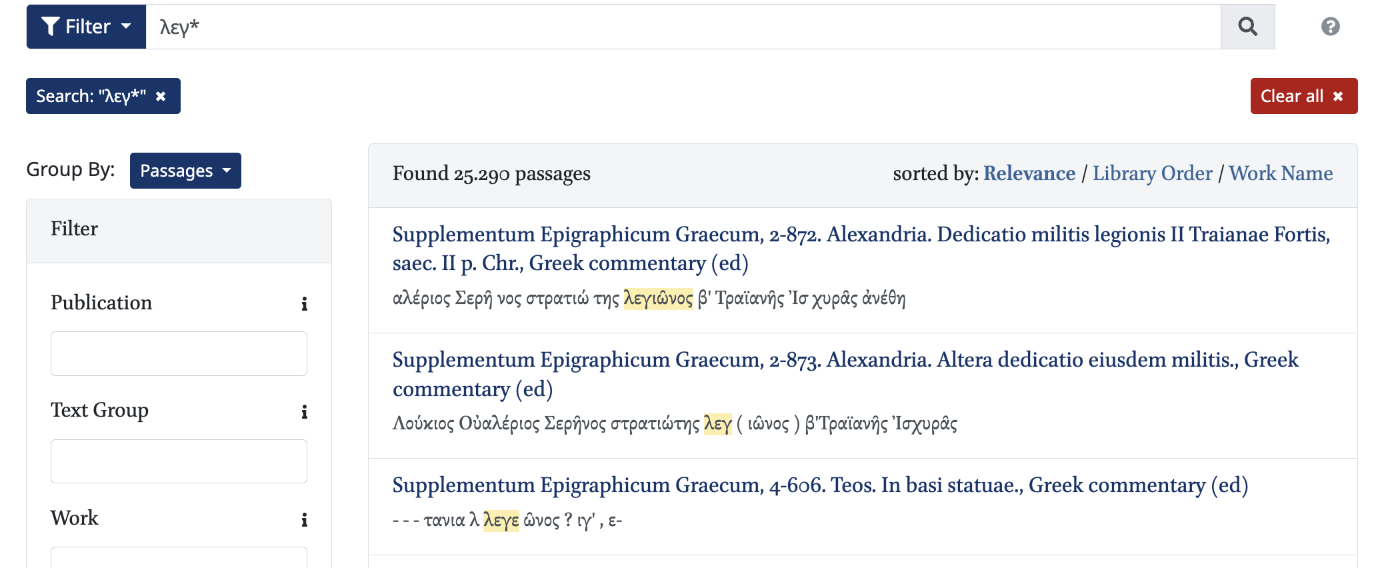
Please note that this search option will include all words with the same root. Hercul* will include passages
with variations of for example Hercules, Herculaneum, Herculanus and Herculianus and Ἡρακλ* will include passages
with variations of, for example, Ἡρακλῆς, Ήρακλείδος, Ήρακλιανός, Ήρακλείτος and Ήρακλεόδωρος. In some cases it
might be more convenient to use search option ~num to include word variations in the search.
() When combining
different search options, it is important to specify the order of search actions. If parenthesis are used,
the search operation within the parenthesis is executed first, then the other search operations will be
executed from left to right. If not indicated, the search engine will automatically execute the search query
from left to right. For example, the search query Περικλῆς -(Ἡρακλῆς | Ἵππιας) will show all results in which
Perikles is mentioned without Herakles and without Hippias.
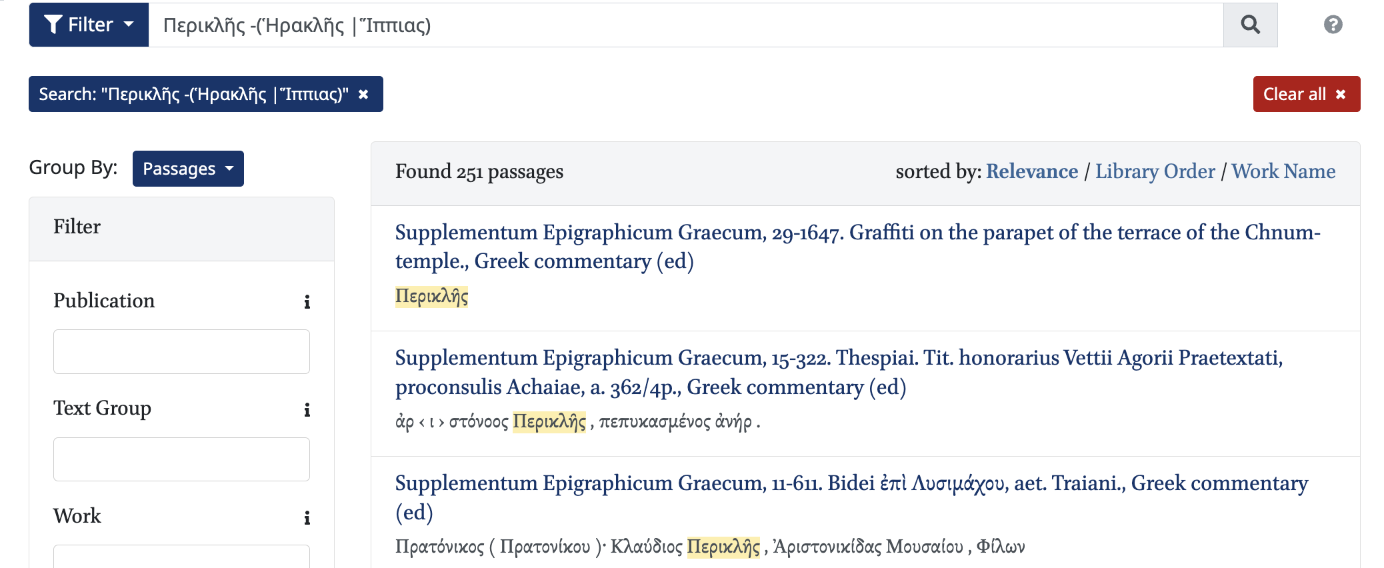
However, the search query Περικλῆς -Ἡρακλῆς | Ἵππιας will give all passages in which Perikles is mentioned without
Herakles and all passages in which Hippias is mentioned:
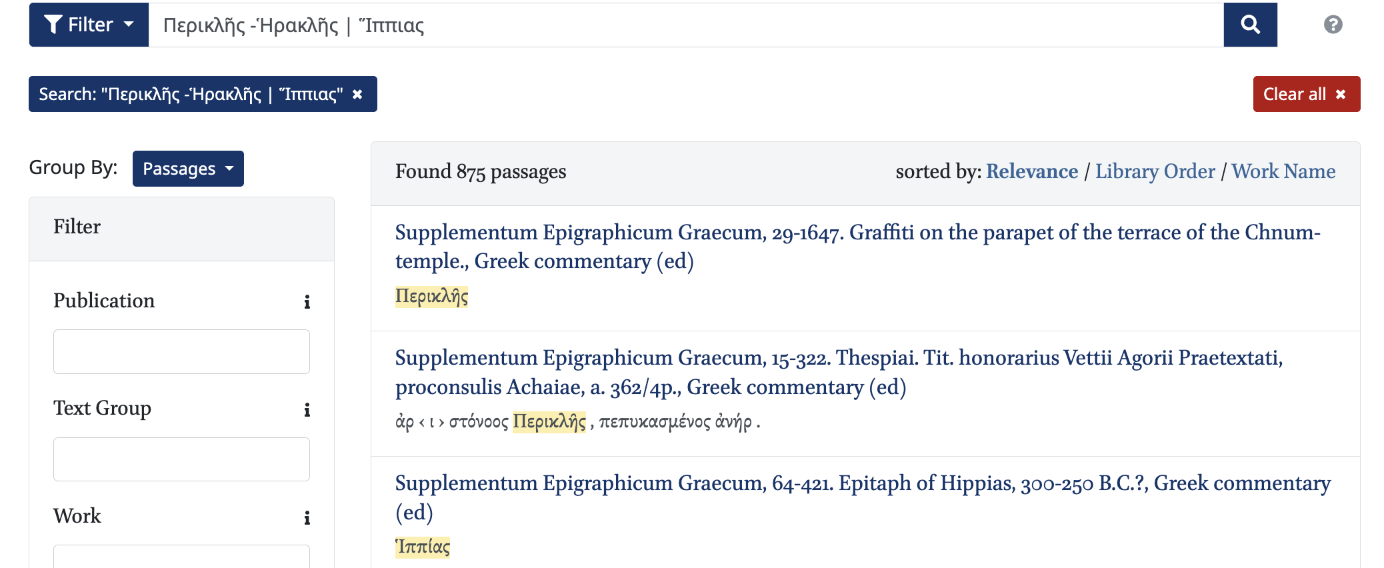
~num Sometimes it might be helpful to allow for letter deviation
in the results. For example, in Greek the name Herakles occurs with different spelling or with different case endings.
To include these deviations add a so-called 'tilde' (~Unicode U+007E) after the word and add the number of letter deviations,
for example Ἡρακλῆς~2.
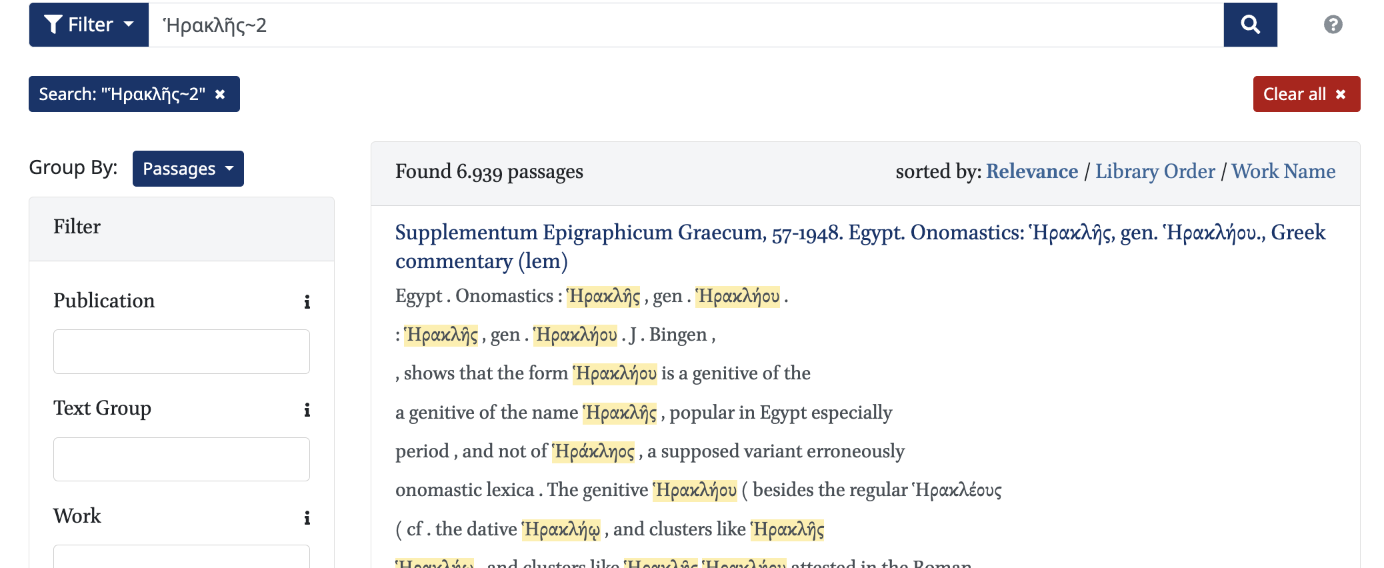
Please note that this search option is not solely limited to variations in the word ending but shows other variations as well.
For example, Περικλῆς also shows results as Προκλῆς, Πασικλῆς, Χαρικλῆς and Ἱεροκλής.
Sometimes it might be helpful to allow for word deviation in the results, when searching for a specific phrase. Put the
phrase inside quotes and add a tilde after a word with the amount of word deviations.
For example, " ἐν μάχῃ"~1 gives all options of " ἐν μάχῃ" including those with one word deviation.
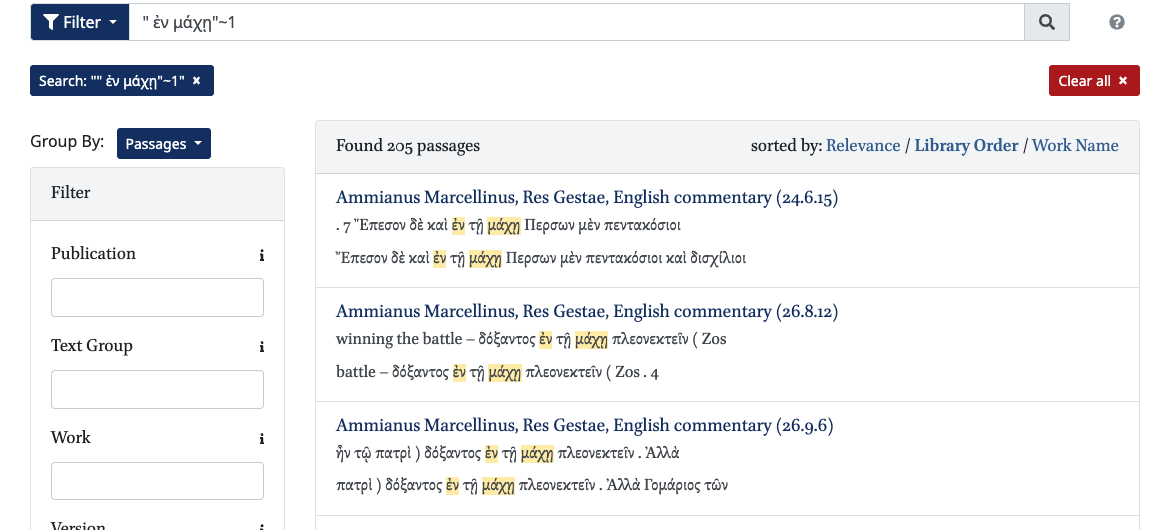
Use the filtered search on the left-hand side
Each publication has a filtered search option, which allows users to search for specific information within the publication.
Filters can be used one by one or combined, to further refine the search. For instance, in Supplementum Epigraphicum Graecum,
users may search for an entry that matches the filters Place (see below: Ephesos), Period (first century BC), and Index term (Slavery)
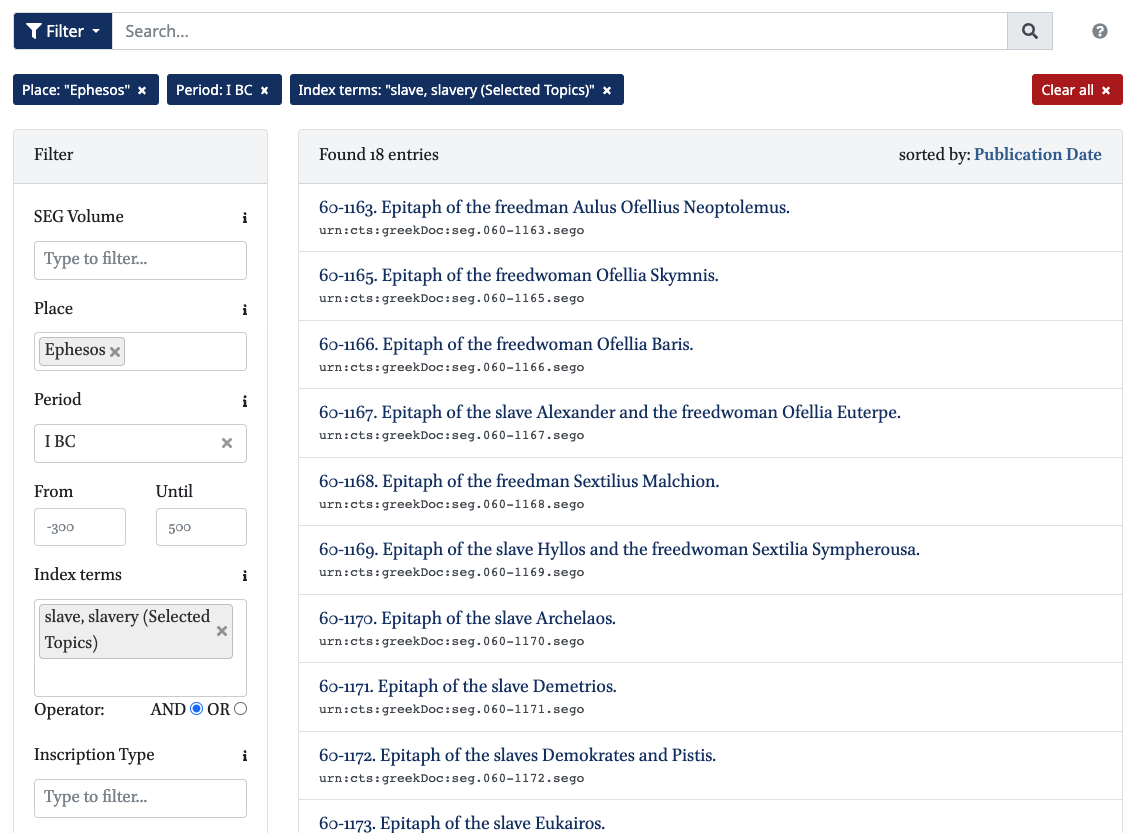
A simple click on the chosen search result will then allow users to enter the Scaife Viewer of Brill's Scholarly Editions.
How do I use the Scaife Viewer on Brill's Scholarly Editions?
The Scaife Viewer is the heart of Brill's Scholarly Editions. It aims to give a focused reading experience in an uncluttered interface.
The Viewer has three panels:
- The Left panel has various options for browsing and searching
- The Center panel is where the text is displayed
- The Right panel contains citation details and various widgets
The left and right-hand panels can be folded in and out using the arrows at the top.
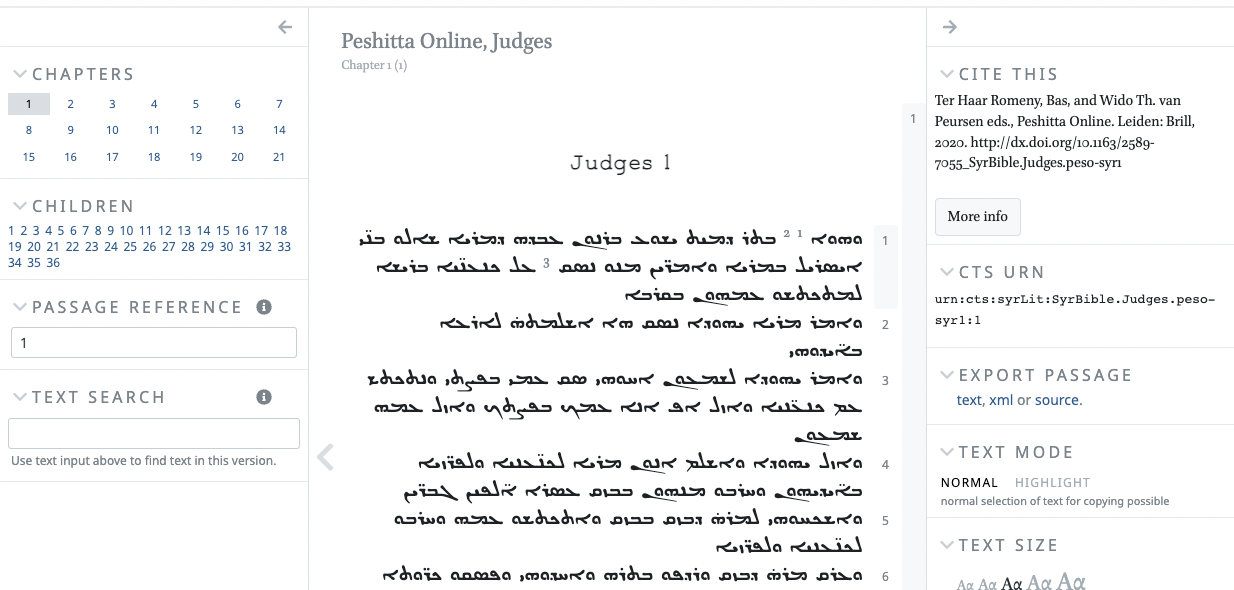
The left panel
The Left Panel has various options for browsing (navigation) and searching. These are:
-
A navigation widget, showing sibling, child, and parent passages (if available). For example, with Peshitta, Judges 7,
the sibling passages are other chapters in the book of Judges. The children of Judges 7 are its 25 versions. This
widget is therefore useful to navigate between related passages: clicking on one will display it in the Viewer
-
Another navigation widget, called Passage reference, where users can manually determine how many passages are displayed in the
Viewer at a given time. For example, with Peshitta, Judges 7 the entire seventh chapter may be displayed by setting this widget
to 7, or specific verses can be selected by entering, for instance, 7.1-7.5
-
The Text search, a full-text search in the version of the publication displayed in the Viewer at a given moment. Search results
(highlighted) are listed below the Text search bar, and can be clicked to display them in the Viewer
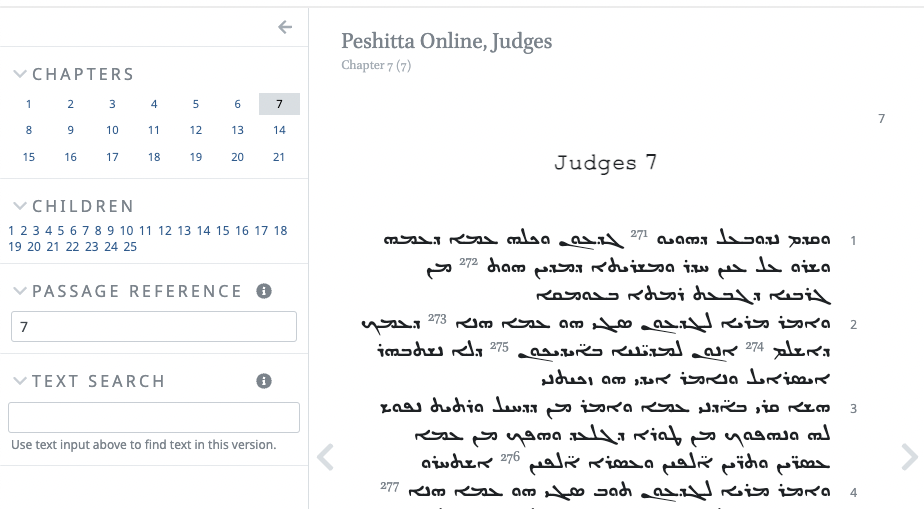
The center panel
The Center Panel is where the text is displayed. It has a number of navigation (browsing) options:
- Previous page and Next page arrows on either side of the text
- A 'breadcrumb' at the top
- A menu termed Add parallel version to display two texts in the Viewer side by side
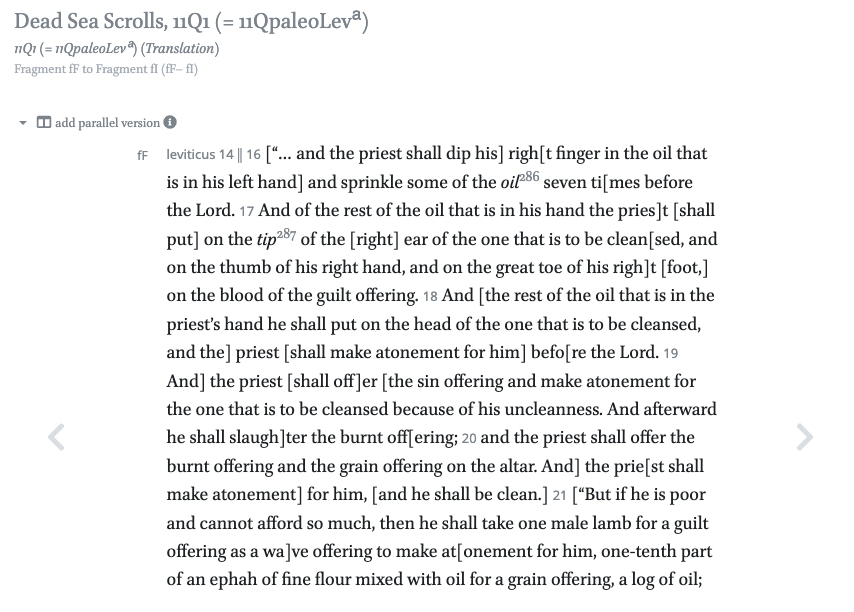
Previous and next page
The Viewer, by default, displays a maximum number of passages on a given page, usually around five paragraphs for prose and 30 lines for verse.
These numbers can be manually changed using the Passage reference widget on the left panel. Arrows on either side of the text allow you to
navigate to the previous passages, or the next, if there are any.
Please bear in mind that first pages have no previous and last pages no next, and that with left-to-right scripts the next arrow is on the left side!
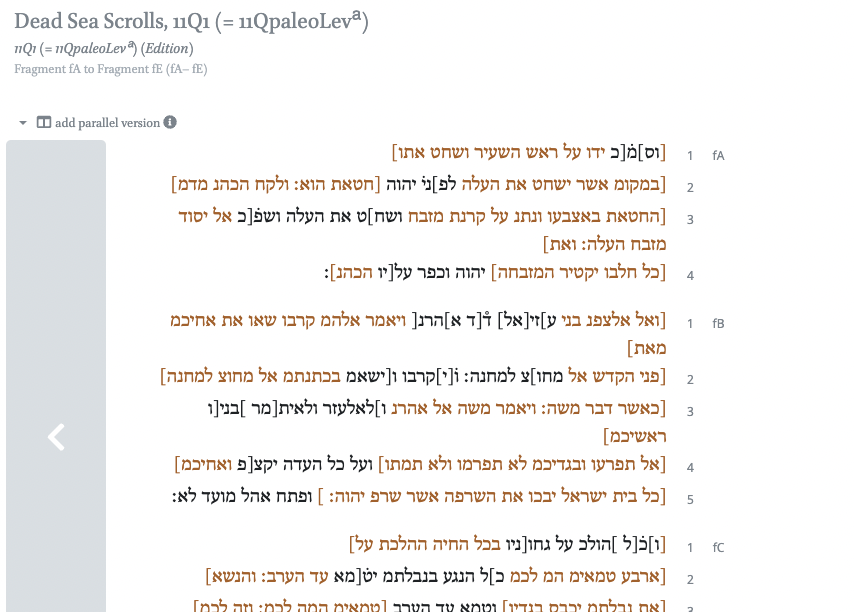
Breadcrumb
The title at the top (left) of the Center Panel acts as a Breadcrumb. It consists of the name of a text
and the name of a work. Click on the name to go back to the home page of the relevant publication.

Add parallel version
The Add parallel version function allows users to add a second text beside the main one in the Viewer, making it possible to read two texts
side by side (for example a source text and a translation). You can compare two versions of the same work, or go from commentary to text and back.
Click on the “Add parallel version” button at the top left of the Center Panel to display a dropdown menu listing all versions of a given work.
Select the one you need and see it appear beside the text already shown in the Viewer.
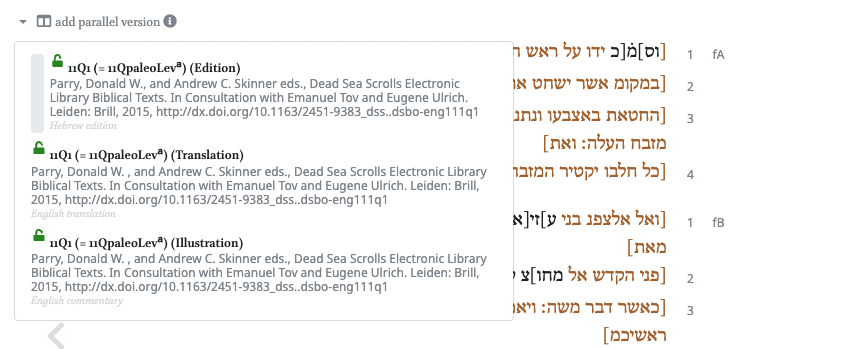
Once the second text is added, the Center Panel is effectively divided into two columns. Both columns now have an “Add parallel version” button.
At the very bottom of the dropdown menu is an option to remove the column.
Please remove a column, before adding a new column. At the moment, there is a maximum of two columns to be shown in the Viewer at the same time.

The right panel
The Right Panel has several widgets, or tools to interact with the text in the Center Panel. At the top of the Right Panel, the citation statement is shown,
indicating how to cite the text in the Viewer. If two columns are open, there will be two different statements.
Below the citation, there are various other widgets. These are:
-
CTS URN. This gives the identifier for the passage(s) displayed in the Viewer.
-
Export passage. This generates plain text or a TEI XML file, either of the passages
shown in the Viewer at that moment, or of the whole version of the text.
-
Text mode. Containing two options. Normal allows users to select and copy text. Highlight means users
can click on a word, or shift-click for a range of words, which will then be highlighted. This action
triggers two other widgets, Highlight and Morphology (see below).
-
Text size. Choice of five sizes.
-
Text width. Choice of five widths.
-
Highlight. This tells the users which word/phrase is highlighted in the text of reference. The number
between square brackets gives the occurrence of the highlighted term in the passage displayed in the Viewer.
-
Morphology. This gives a grammatical analysis of a highlighted word (this option is currently active for Latin, Greek, and Syriac).
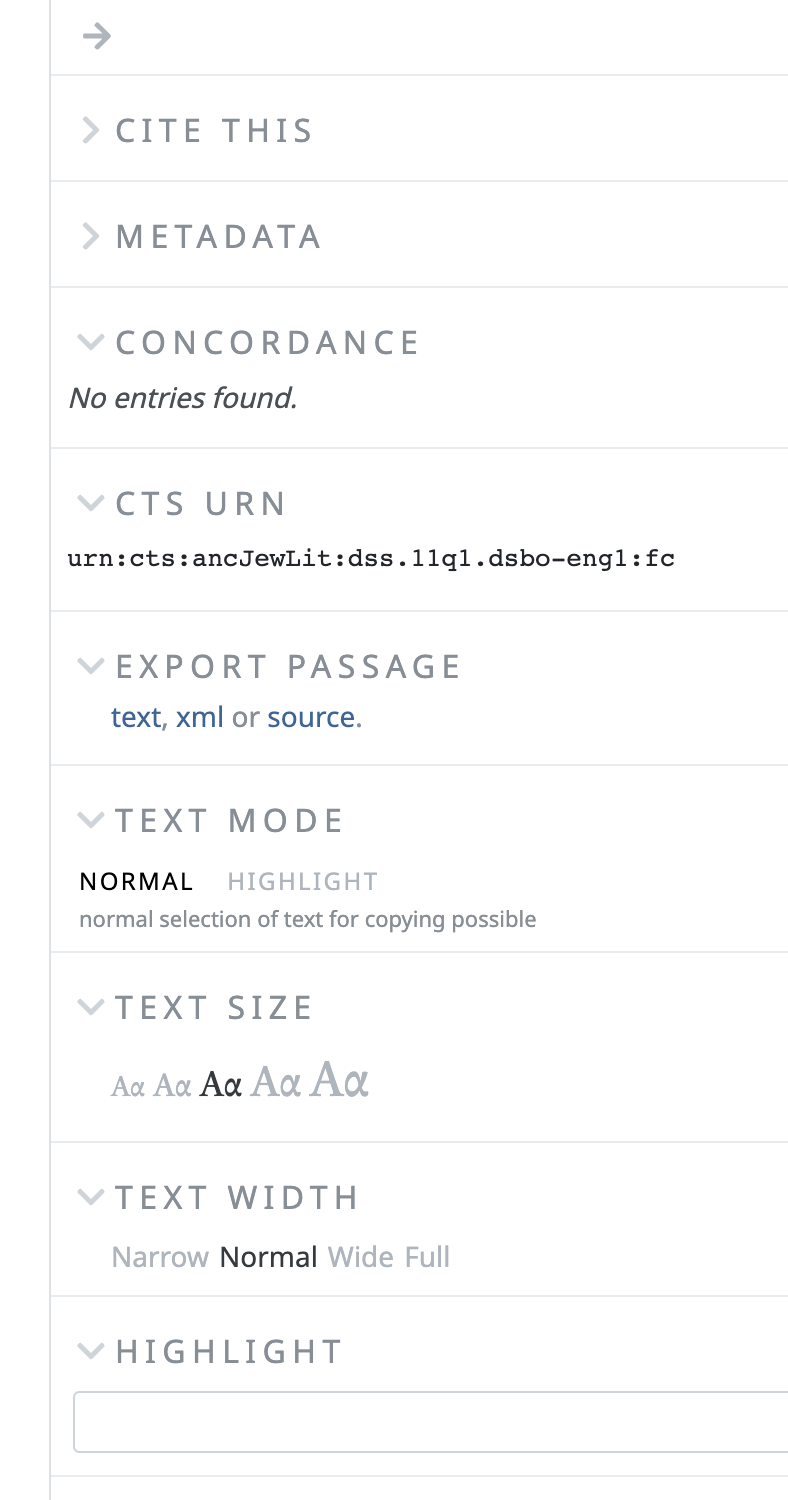
More widgets may be developed as new content is added to the library.





















